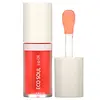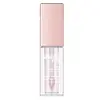What's inside
What's inside
 Key Ingredients
Key Ingredients

 Benefits
Benefits

 Concerns
Concerns

 Ingredients Side-by-side
Ingredients Side-by-side

Polyglyceryl-2 Isostearate/Dimer Dilinoleate Copolymer
EmollientHelianthus Annuus Seed Oil
EmollientSimmondsia Chinensis Seed Oil
EmollientTocopheryl Acetate
AntioxidantOlea Europaea Fruit Oil
MaskingSilica Dimethyl Silylate
EmollientCamellia Japonica Seed Oil
EmollientPolyhydroxystearic Acid
EmulsifyingCamellia Sinensis Seed Oil
HumectantArgania Spinosa Kernel Oil
EmollientMacadamia Integrifolia Seed Oil
Skin ConditioningCeramide NP
Skin ConditioningParfum
MaskingRosa Damascena Flower Water
MaskingLecithin
EmollientIsostearic Acid
CleansingIsopropyl Myristate
EmollientEthylhexyl Palmitate
EmollientDiisostearyl Malate
EmollientDehydroacetic Acid
PreservativePolyglyceryl-3 Polyricinoleate
EmulsifyingMonascus Extract
Skin ConditioningWater
Skin ConditioningButylene Glycol
HumectantMentha Viridis Leaf Oil
AstringentCI 15850
Cosmetic ColorantEclipta Prostrata Extract
Skin ConditioningCI 15985
Cosmetic Colorant1,2-Hexanediol
Skin ConditioningMelia Azadirachta Leaf Extract
Skin ConditioningMoringa Oleifera Seed Oil
EmollientRubus Idaeus Fruit Extract
AstringentVaccinium Angustifolium Fruit Extract
Skin ProtectingMorus Alba Root Extract
BleachingFragaria Vesca Fruit Extract
AstringentOriganum Vulgare Leaf Extract
Skin ConditioningChamaecyparis Obtusa Leaf Extract
Skin ConditioningSalix Alba Bark Extract
AstringentLactobacillus/Soybean Ferment Extract
Skin ConditioningPortulaca Oleracea Extract
Skin ConditioningCinnamomum Cassia Bark Extract
MaskingScutellaria Baicalensis Root Extract
AstringentPolyglyceryl-2 Isostearate/Dimer Dilinoleate Copolymer, Helianthus Annuus Seed Oil, Simmondsia Chinensis Seed Oil, Tocopheryl Acetate, Olea Europaea Fruit Oil, Silica Dimethyl Silylate, Camellia Japonica Seed Oil, Polyhydroxystearic Acid, Camellia Sinensis Seed Oil, Argania Spinosa Kernel Oil, Macadamia Integrifolia Seed Oil, Ceramide NP, Parfum, Rosa Damascena Flower Water, Lecithin, Isostearic Acid, Isopropyl Myristate, Ethylhexyl Palmitate, Diisostearyl Malate, Dehydroacetic Acid, Polyglyceryl-3 Polyricinoleate, Monascus Extract, Water, Butylene Glycol, Mentha Viridis Leaf Oil, CI 15850, Eclipta Prostrata Extract, CI 15985, 1,2-Hexanediol, Melia Azadirachta Leaf Extract, Moringa Oleifera Seed Oil, Rubus Idaeus Fruit Extract, Vaccinium Angustifolium Fruit Extract, Morus Alba Root Extract, Fragaria Vesca Fruit Extract, Origanum Vulgare Leaf Extract, Chamaecyparis Obtusa Leaf Extract, Salix Alba Bark Extract, Lactobacillus/Soybean Ferment Extract, Portulaca Oleracea Extract, Cinnamomum Cassia Bark Extract, Scutellaria Baicalensis Root Extract
Polyglyceryl-2 Isostearate/Dimer Dilinoleate Copolymer
EmollientCaprylic/Capric Triglyceride
MaskingDiisostearyl Malate
EmollientSimmondsia Chinensis Seed Oil
EmollientTocopheryl Acetate
AntioxidantRosa Canina Fruit Oil
EmollientMacadamia Ternifolia Seed Oil
EmollientLimnanthes Alba Seed Oil
Skin ConditioningPrunus Amygdalus Dulcis Oil
Skin ConditioningArgania Spinosa Kernel Oil
EmollientOlea Europaea Fruit Oil
MaskingHelianthus Annuus Seed Oil
EmollientEclipta Prostrata Extract
Skin ConditioningMelia Azadirachta Leaf Extract
Skin ConditioningRosa Damascena Flower Oil
MaskingMoringa Oleifera Seed Oil
EmollientIsostearic Acid
CleansingDehydroacetic Acid
PreservativeParfum
MaskingCI 45410
Cosmetic ColorantCitronellol
PerfumingGeraniol
PerfumingEugenol
PerfumingBenzyl Alcohol
PerfumingLimonene
PerfumingLinalool
PerfumingHexyl Cinnamal
PerfumingPolyglyceryl-2 Isostearate/Dimer Dilinoleate Copolymer, Caprylic/Capric Triglyceride, Diisostearyl Malate, Simmondsia Chinensis Seed Oil, Tocopheryl Acetate, Rosa Canina Fruit Oil, Macadamia Ternifolia Seed Oil, Limnanthes Alba Seed Oil, Prunus Amygdalus Dulcis Oil, Argania Spinosa Kernel Oil, Olea Europaea Fruit Oil, Helianthus Annuus Seed Oil, Eclipta Prostrata Extract, Melia Azadirachta Leaf Extract, Rosa Damascena Flower Oil, Moringa Oleifera Seed Oil, Isostearic Acid, Dehydroacetic Acid, Parfum, CI 45410, Citronellol, Geraniol, Eugenol, Benzyl Alcohol, Limonene, Linalool, Hexyl Cinnamal
Alternatives
Ingredients Explained
These ingredients are found in both products.
Ingredients higher up in an ingredient list are typically present in a larger amount.
You may know this ingredient as argan oil. Argan Oil has antioxidant, hydrating, and soothing properties.
Studies have shown argan oil can help fight again radical damage from the sun. This makes it effective at preventing hyperpigmentation.
Large amounts of vitamin E found in argan oil helps the skin retain water. Argan oil also contains fatty acids such as linoleic acid, oleic acid, and palmitic acid. It is also a good source of lipids.
Another benefit of argan oil is skin-soothing. It can help reduce inflammation-related skin symptoms.
Argan Oil is effective at regulating sebum production in pores. This can make it effective at treating hormonal acne.
Traditionally, argan oil was used for its antibacterial and antifungal properties. However, argan oil contains fatty acids that may make it not fungal-acne safe.
Argan Trees are native to Morocco.
Learn more about Argania Spinosa Kernel OilDehydroacetic Acid is fungicide and bactericide. It is used as a preservative in cosmetics. Preservatives help elongate the shelf life of a product.
Dehydroacetic Acid is not soluble in water.
Diisostearyl Malate is an emollient and most often used in lip products. It comes from isostearyl alcohol, a fatty acid, and malic acid, an AHA.
As an emollient, Diisostearyl Malate helps create a thin film on your skin to trap moisture in. This helps keep your skin soft and smooth.
This ingredient is also known as Bhringaraj extract or False Daisy. It has skin conditioning properties and is rich in antioxidants.
Helianthus Annuus Seed Oil is the oil derived from the seeds of a Sunflower. Sunflower seed oil is non-fragrant. It is an emollient, meaning it helps to soften the skin.
Sunflower seed oil contains many fatty acids. The fatty acids found in sunflower seeds include (from highest amount to least): linoleic acid, myristic acid, palmitic acid, stearic acid, arachidic acid, oleic acid, and linolenic acid.
These fatty acids help the skin create ceramides. Ceramides play a role in repairing the skin barrier.
Helianthus Annuus Seed Oil helps moisturize the skin. This in turn helps the skin look more rejuvenated and smoother.
Sunflowers are rich in vitamin E.
Historians believe Indigenous cultures of North America domesticated sunflowers before corn. Thus they relied on sunflower oil for a variety of uses. One such use is moisturizing skin and hair.
Sunflower seed oil may not be fungal acne safe. We recommend speaking with a professional if you have any concerns.
Learn more about Helianthus Annuus Seed OilIsostearic acid is a saturated fatty acid. Its structure makes it a great surfactant.
Surfactants help decrease the surface tension between two liquids. This property also makes it an effective emulsifier. Emulsifiers help prevent waters and oils from separating in a product.
Isostearic Acid is created from oleic acid.
This ingredient may not be Malassezia folliculitis, or fungal-acne safe.
Learn more about Isostearic AcidMelia Azadirachta Leaf Extract is extract from the neem plant.
The leaves of this tree contain flavonoids and polyphenols. These two compounds are antioxidants, anti-inflammatory, and antibacterial. Further research is needed as to their effects when applied on skin.
Moringa Oleifera Seed Oil is the oil expressed from the seeds of Moringa oleifera plant. It is more commonly known as Moringa seed oil.
Moringa seeds have antioxidant, anti-inflammatory, and skin hydrating properties. These seeds are rich in oils, proteins, monounsaturated fats, and tocopherols.
As an emollient, moringa seed oil helps trap moisture in the skin by creating a film on top. This helps keep your skin hydrated and soft.
Many compounds in moringa seed oil are antioxidant and anti-inflammatory. These compounds include Vitamin E. , catechins, ferulic acid, and more.
Another compound found in Moringa seed oil is oleic acid.
Moringa trees are native to the Himalayan mountains.
This ingredient may not be fungal-acne safe.
Learn more about Moringa Oleifera Seed OilOlea Europaea Fruit Oil is the fixed oil obtained from the ripe fruit of the Olive. In other words - olive oil.
The primary contents of olive oil are glycerides of the fatty acids linoleic, oleic and palmitic.
Olive oil also contains antioxidants such as Vitamin E. Antioxidants may help reduce signs of aging by fighting unstable free-radical molecules. It also contains Vitamins A (retinol), D, and K.
The squalene in olive oil makes it a great emollient. Emollients help soothe and soften your skin by trapping moisture in. This makes olive oil a great skin moisturizer.
Studies show olive oil to have antibacterial and antifungal properties in low concentrations. Another study found olive oil irritated sensitive oily skin. We always recommend speaking with a professional about using this ingredient in your routine.
Due to the fatty acid content, this ingredient may not be fungal-acne safe.
Learn more about Olea Europaea Fruit OilParfum is a catch-all term for an ingredient or more that is used to give a scent to products.
Also called "fragrance", this ingredient can be a blend of hundreds of chemicals or plant oils. This means every product with "fragrance" or "parfum" in the ingredients list is a different mixture.
For instance, Habanolide is a proprietary trade name for a specific aroma chemical. When used as a fragrance ingredient in cosmetics, most aroma chemicals fall under the broad labeling category of “FRAGRANCE” or “PARFUM” according to EU and US regulations.
The term 'parfum' or 'fragrance' is not regulated in many countries. In many cases, it is up to the brand to define this term.
For instance, many brands choose to label themselves as "fragrance-free" because they are not using synthetic fragrances. However, their products may still contain ingredients such as essential oils that are considered a fragrance by INCI standards.
One example is Calendula flower extract. Calendula is an essential oil that still imparts a scent or 'fragrance'.
Depending on the blend, the ingredients in the mixture can cause allergies and sensitivities on the skin. Some ingredients that are known EU allergens include linalool and citronellol.
Parfum can also be used to mask or cover an unpleasant scent.
The bottom line is: not all fragrances/parfum/ingredients are created equally. If you are worried about fragrances, we recommend taking a closer look at an ingredient. And of course, we always recommend speaking with a professional.
Learn more about ParfumWe don't have a description for Polyglyceryl-2 Isostearate/Dimer Dilinoleate Copolymer yet.
This oil comes from the seeds of the desert shrub called Jojoba. It is more commonly known as jojoba oil, a non-comedogenic oil.
Jojoba oil does not contain fragrance and has many fatty-acids, making it a great soothing ingredient.
It also contains Vitamin E, a great moisturizing ingredient. Vitamin E is also an antioxidant and protects your skin against oxidative damage.
This ingredient humectant properties, meaning it helps draw moisture from the air. This helps keep your skin hydrated.
While jojoba has antibacterial properties, it is only able to kill some strains of bacteria.
Studies also show it helps in wound healing. In fact, Indigenous cultures have used jojoba as a moisturizer and to help treat burns for centuries.
Fun fact: Jojoba oil similar to natural human skin sebum, so it has a great effect on dry skin. It is also promising with helping to regulate sebum production.
Due to its fatty acid content, Jojoba oil may not be fungal acne safe. We recommend speaking with a professional if you have any concerns.
Learn more about Simmondsia Chinensis Seed OilTocopheryl Acetate is AKA Vitamin E. It is an antioxidant and protects your skin from free radicals. Free radicals damage the skin by breaking down collagen.
One study found using Tocopheryl Acetate with Vitamin C decreased the number of sunburned cells.
Tocopheryl Acetate is commonly found in both skincare and dietary supplements.
Learn more about Tocopheryl Acetate